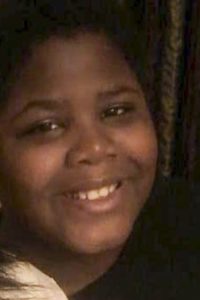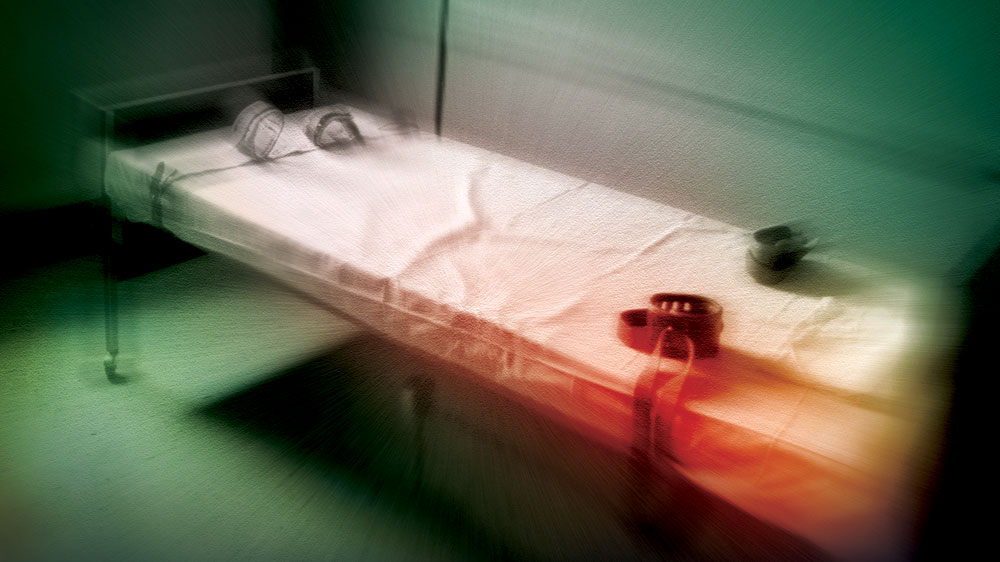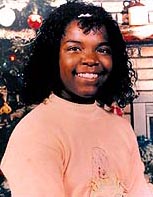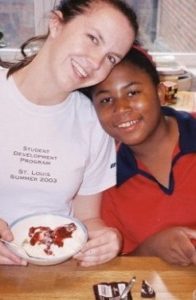Psychiatric restraints are socially invisible and should be prohibited. Funds should be redirected to effective, not racist “mental health” programs for Black communities.
Rev. Frederick Shaw is a long-term civil rights campaigner, Executive Director of the NAACP Inglewood-South Bay branch and a spokesperson for the Citizens Commission on Human Rights International (CCHR). He helped obtained three national NAACP resolutions against drugging and electroshocking of children.
Ms. Jan Eastgate, President CCHR International, has worked investigating and exposing abuses in the mental health industry for more than 40 years, and has written reports on psychiatric and psychological racism in the U.S., Australia and South Africa. Ms. Eastgate and Rev. Shaw both attended and presented evidence of this to South Africa’s Truth & Reconciliation Commission investigating apartheid crimes in 1997.
By Rev. Frederick Shaw and Jan Eastgate
Mental Health Industry Watchdog
June 9, 2020
Like millions of others, we join in the calls for justice and a stop to racism, following the recent tragic death during a police restraint hold. We are encouraged by such a united voice and, as an extension of that, draw attention to “legal” restraint abuse that is not socially visible—behind psychiatric “hospital” walls.

16-year-old Cornelius Frederick died after he was physically restrained at Sequel Youth & Family Services’ Lakeside Academy in Kalamazoo, Michigan
The tragic deaths of African Americans in psychiatric facilities is rarely discussed. On April 30, 2020, 16-year-old Cornelius Frederick, an African American boy, was physically restrained at Sequel Youth & Family Services’ Lakeside Academy in Kalamazoo, Michigan, a residential psychiatric facility that treats foster care and other kids with behavioral issues. According to the family’s attorney, Frederick started yelling, “I can’t breathe!” before passing out. Thirty hours later, he was dead.[1]
Frederick was described by family members as “a boy’s boy,” with a penchant for playing jokes and pranks. He was sweet, too. Frederick had been a ward of the state since 2014, after his mother passed away and his father’s parental rights were revoked, according to Jon Marko, the Detroit-based civil rights attorney representing Frederick’s family. A witness said, “[T]his kid threw a sandwich. He was being unruly and they couldn’t control him. So, four guys…the size of rugby players, tackled him.’”[2]
On May 29, the National Juvenile Justice Network announced that the Michigan Center for Youth Justice is seeking justice for Cornelius Fredrick and campaigning to shut down Sequel Youth and Family Services from operating in Michigan as well as around the country. The group started a petition to get Justice for Cornelius and Shut Sequel Down, which CCHR supports. Please sign.[3]
The fact is that restraint use should be banned across the boards. CCHR has been documenting restraint deaths in psychiatric facilities, especially those in for-profit behavioral hospitals, for decades. Consider the following alarming statistics from research:
- African Americans are over-represented in restraint-related deaths of children and adults with disabilities, accounting for 22% of the deaths studied while representing only 13% of the U.S. population.[4]
- In one state, as an example, African Americans are disproportionately subjected to coercive and restrictive measures, including 72-hour involuntary commitment, seclusion, restraints and forcibly drugged.[5]
- According to the 2015-2016 Civil Rights Data Collection of School Climate and Safety (2018) for the nation, African American students also receive disproportionate discipline in schools. Representing about 15% of the total enrollment, African American students accounted for 27% of restraints and 23% of seclusion in schools.[6]
In 1999, federal regulations were passed to make psychiatric restraint deaths more accountable but with little impact. It followed The Hartford Courant series that found up to 150 restraint deaths occurring each year in the U.S. One of those deaths was a 16-year-old African American girl, Roshelle Clayborne, a ward of the state, who while at the Laurel Ridge psychiatric treatment center in Texas, was slammed face-down on the floor in a restraint hold. “I can’t breathe,” she pleaded. She became suddenly still, blood trickled from the corner of her mouth as she lost control of her bodily functions. Her limp body was rolled into a blanket and dumped in a seclusion room. No one watched her die, the Hartford Courant reported.[7]
In another case, 11-year-old foster child, Andrew McClain refused to obey a psychiatric aide’s order to move to another dining table at Elmcrest psychiatric hospital in Texas and was escorted to a “time out” room where he was restrained. Little more than an hour later, Andrew was pronounced dead, suffocated in a restraint hold administered him.[8]
CCHR has continued to document restraint deaths, especially in for-profit psychiatric facilities and the stereotyping of African Americans, Blacks, Latinos, Native Americans and minorities in the mental health system.
In 2010, 16-year-old Alexis Evette Richie lay motionless and sprawled face down on a bean bag chair at the adolescent psychiatric ward at SSM DePaul Health Center in Missouri. The foster child had been unruly, trying to hit, scratch and bite staff members. Two aides grabbed her arms and took her down a hall and into a small room called the “quiet room.” They held her face down, while a nurse injected a sedative into her hip. Alexis continued to struggle and then went limp. The nurse and the two aides left without checking her pulse or making sure she was breathing. It was 12 minutes after she stopped moving before anyone tried to revive Alexis. By then it was too late. The medical examiner agreed, concluding that Alexis had suffocated on the bean bag chair. Her death was ruled a homicide.[9] No criminal charges were filed.[10]
- As the Louis Post-Despatch reported, Alexis had been abused and abandoned in her short life. Her medical and foster-care records indicated that Missouri child-welfare officials removed her from her home at age 7, after she’d been sexually abused by a family friend. She bounced around foster homes and institutions. Around age 11, she tried to kill herself by running into traffic. She was admitted to DePaul on Oct. 16, 2009, after stabbing a teacher at Evangelical Children’s Home with a pencil. Yet she was cheerful and attentive—but was often angry or tearful. She got shots of two drugs, Ativan and the Geodon. [11] (Both psychotropic drugs could have induced violent behavior.)
- On November 19, 2017, Jeremiah Flemming, a 15-year-old African American, died after a mental health technician physically restrained him at North Spring Behavioral Healthcare in Leesburg, North Virginia. His mother, Kinnisha Flemming, told The Washington Post, her son “didn’t deserve the way he died.” The state medical examiner concluded the teen died of asphyxiation. Jeremiah had been bullied and had become agitated and started punching the walls before he was restrained during the incident. About two minutes into the hold, a nurse observed that Jeremiah dropped his head down and sounded like he was snoring.[12] The boy was later found unresponsive and not breathing. He was taken to a local hospital where he died.[13] In 2018, an employee who had been charged with involuntary manslaughter over Jeremiah’s death, was acquitted, raising concerns about psychiatric restraint deaths being excused as “accidental killings.”[14]
- In case of Cornelius Frederick, the Kalamazoo police department is investigating the incident, but as of the date of writing, no arrests have been laid over the death.[15] The Michigan Department of Health and Human Services also launched an investigation into the facility and is reviewing its license. The investigation indicates a staff member was suspended after reports of slapping, choking and scratching a student in January. That same staff member had been disciplined months earlier for improper supervision of a resident, according to the report.[16]
- Nationwide, Sequel Youth & Family services treats about 10,000 children and adolescents.[17] It has come under government scrutiny over its treatment of foster care and other youth. Only last August Sequel’s Red Rock Canyon School in Utah closed after “numerous accounts of mistreatment, abuse, acts of violence and overall disrespect toward residents.” Sequel Pomegranate reached a settlement with the Ohio Department of Mental Health and Addiction Services after facing a license revocation due to use of improper restraints and sexual abuse of patients and violence in the facility. One teen was kicked, punched and improperly restrained by a nurse and mental health aide. [18]
Beware Mental Health Funds Offered to “Treat” Racism Effects
African Americans, Latinos and minorities should be warned about current government offers to increase mental health funding to “treat” them. Some Congresspersons have already proposed redirecting some funding toward addressing mental health.[19]
Beware the American Psychiatric Association (APA) that would benefit from such funding and are offering “treatment.” It brings with it a false science that offers help, but harms.
The road to incarceration can occur when a child is labeled a troublemaker or is diagnosed with a mental illness, which can “put them into the pipeline for prison,” speakers told a Harvard T.H. Chan School of Public Health audience in 2015.[20]
According to one study, African Americans who experience the most racism are more likely to be labeled with Post-Traumatic Stress Disorder (PTSD).[21] But to oppress a race, and then label its normal but frightening reactions to this as a ‘mental illness,’ and drug it, is morally wrong, dangerous and a betrayal. It’s not that the painful responses are not real—they are. But they are not a “disease.” Consider the usual “treatment” for PTSD: antidepressants, which include Prozac, Zoloft, Effexor and Paxil.[22] The drugs can cause nervousness, agitation, restlessness, hallucinations, suicidal behavior and sexual problems.[23]
Patrick D. Hahn, Affiliate Professor of Biology, Loyola University Maryland, also warns, “The link between antidepressants and violence, including suicide and homicide, is well established.”[24] Post-withdrawal symptoms from antidepressants “may last several months to years” and include disturbed mood, emotional lability [excessive emotional reactions and frequent mood changes], and irritability. [25]
That the APA now speaks out opposing racism is hypocritical.
Psychiatrists Invent “Protest Psychosis”
During the Civil Rights movement in the 1960s, psychiatrists invented the term “protest psychosis” to describe Blacks participating in the movement.[26] It was used to stereotype them as aggressive with claims that joining in Black protests was a symptom of “schizophrenia.” Psychiatrists writing in the International Journal of Social Psychiatry said that Blacks developed delusions, grandiosity, magical thinking, and “dangerous aggressive dealings” when they joined civil rights sit-ins.[27]
Advertisements for powerful antipsychotic drugs in psychiatric journals showed angry Black men or African tribal symbols to influence the prescriptions of these physically damaging drugs, to African Americans.[28]
- Following the civil rights movement, stereotyping or profiling Blacks as criminals became so pervasive throughout society that “criminal predator” was used as a euphemism for “young Black male,” a report in the Journal of Contemporary Criminal Justice[29]
- In 2017, The American Journal of Psychiatry, “Addressing the Legacy of Racism in Psychiatric Training,” covered this era and today: “The Abolitionist and Civil Rights movements were met with mistrust and prejudice by mental health practitioners. African Americans, angry about their oppression, were labeled ‘schizophrenic,’ due to their supposed ‘pathological’ reaction of emotional disharmony, hostility, and aggression. The over-diagnosis of schizophrenia among African Americans persists today, along with myriad other racial inequities in mental health practice.”[30]
- A New York Law School Journal report in 2017 reported continued psychological profiling: “Behavior by African-Americans is more often interpreted as ‘dangerous’ than identical behavior by whites. African Americans are also more often diagnosed with a psychiatric ‘conduct disorder’ than whites.”[31]
- Research shows that within the population of people admitted to state psychiatric hospitals, African Americans are almost five times more likely to be diagnosed with schizophrenia as compared with Euro-Americans.[32]
- Today, there is still an over-representation of antipsychotic drug use among African Americans and harmful psychotropic drugs are prescribed to African American children as young as 18 months.[33]
- Antipsychotics cause long-term severe side effects such as tardive dyskinesia (tardive meaning “late” and dyskinesia meaning, “abnormal movement of muscles”), which is marked by abnormal muscular movements and gestures. Tardive dyskinesia causes permanent damage to the nervous system. Several studies show it to be significantly more prevalent among African Americans than among whites.[34] A second effect is akathisia [a, without; kathisia, sitting; an inability to keep still] or extreme restlessness, which can lead to violent behavior.[35] Sexual dysfunction is common in those taking antipsychotics.[36] Atypical (new) antipsychotic drugs can induce diabetes, as well as obesity.[37] African American men in particular are most likely to receive excessive doses of these drugs.[38]
“Medical Model” Creates Racism
In 1792, Benjamin Rush, the “father of American psychiatry” and still the icon of the APA today, declared that Blacks suffered from a disease called Negritude, which he theorized derived from leprosy. The “cure” was when the skin turned “white.” Like lepers, he said, they needed to be segregated for their own good and to prevent their “infecting” others.[39]
While Rush is promoted as anti-slavery and was a signatory of the Declaration of Independence, he was a slave owner, purchasing a child slave that he later freed for compensation. Until 2015, the trademarked seal of the APA featured Rush, a racist and slave owner; APA still uses it for ceremonial purposes and internal documents.[40] There’s also an APA annual award given in his name.[41]
Rush provided a “medical model”—still evident today—to justify post-slavery, “modern” racism, rationalizing, for example, that Blacks were able to endure surgical operations and pain with ease compared to whites. He wrote of cases where “Negroes” had held the upper part of a limb during amputation, calling this “pathological insensibility.”[42]
Runaway slaves were diagnosed with Drapetomania (drapetes, runaway slave, and mania, meaning crazy) and Dyasethesia Aethiopis (laziness and impaired sensation). According to Dr. Samuel A Cartwright, Drapetomania caused Blacks to have the “uncontrollable urge” to escape from their “masters.” The “treatment” was “whipping the devil out of them” and was justified in “medical” terms that whipping made idle Blacks “take active exercise” that vitalized blood to their brain “to give liberty to the mind.”[43] It was further asserted that Blacks were more durable to pain because they had evolved physiologically under the conditions of slavery.[44] Another term for it, as discussed in a 2019 article, is “Black hardiness.”[45]
In 1997, we presented CCHR’s submission on the racist history of psychiatry and psychology in South Africa to the country’s Truth and Reconciliation Commission (TRC) investigating apartheid crimes. Dozens of studies were provided showing how psychiatric-psychological racism had permeated and remained entrenched in educational, medical, government and judicial fields since the early 1900s. The theory that Blacks feel less pain was evidenced by one study on electroshock treatment—up to 460 volts of electricity sent through the brain—given to Blacks without anesthetic because it was claimed they were more “susceptible to the effects of anesthetics.”[46] And unlikely to feel the pain of violent shock treatment.
Astoundingly, in a January 2020 article, Janice A. Sabin, Ph.D., MSW, research associate professor in the Department of Biomedical Informatics and Medical Education at the University of Washington School of Medicine, showed this still stereotypical view in medicine. She wrote: “Half of white medical trainees believe such myths as black people have thicker skin or less sensitive nerve endings than white people.” Sabin concluded: “As a nation, we must continue to reckon with the lingering history of racism in medicine.”[47]
This is even more egregious in the mental health-psychopharmacology industry, where psychiatric disorders are based on opinion about behaviors and not on a medical or scientific test that can physically confirm any mental disorder. In fact, Professor Herb Kutchins, co-author of the renowned book Making Us Crazy: The Psychiatric Bible and the Creation of Mental Disorders warns about the APA’s Diagnostic and Statistical Manual for Mental Disorders (DSM), stating: “Defenders of slavery, proponents of racial segregation…have consistently attempted to justify oppression by inventing new mental illnesses and by reporting higher rates of abnormality among African-Americans or other minorities.”
In an October 2019 review of Kirk Johnson, Ph.D.’s book, Medical Stigmata: Race, Medicine, and the Pursuit of Theological Liberation, Audrey Farley wrote, “Despite lacking scientific basis, race-based medicine is gaining currency and even expanding to the pharmaceutical industry.” Johnson’s book, she says, “chronicles race-based medicine’s development from the eugenics era to the present day, where it is often applied for commercial purposes. Johnson argues that this form of medicine might seem to benefit minority communities by promising greater precision, but it actually does the opposite.”[48] “When the concept of race is used in medicine and pharmacology, it continues to assert that minorities are ‘other’ human beings,” says Johnson.[49] This has been used to “justify immigration restrictions, anti-miscegenation [mixed-race marriage] laws, involuntary sterilization, and other selective breeding practices.”[50]
Eugenics (meaning “good stock”) was developed by English psychologist Frances Galton in 1883. Eugenics was used for selective breeding as a mechanism to increase desirable traits in a population while restricting and eliminating undesirable traits. Galton claimed, “The average intellectual standard of the Negro is some two grades below our own.” Eugenics has prevailed, heavily influencing medical, social, and academic systems.
Much needs to be done to undo the damage done by centuries of psychiatric/psychological racism and the social policies it has engendered.
As a start, NAACP Inglewood-South Bay office and CCHR International are working together to produce materials for African Americans to educate them about continuing racism in mental health field as well as the alternatives to what has become harm in the name of mental health care.
This will include what effective educational; art, music and sports education in schools, and holistic medical programs that funding would be better re-directed to, legal forms that can be signed to protect against enforced psychiatric treatment or mental health profiling (screening) of schoolchildren. “Know Your Rights” will be a tool kit for minorities to help identify and protect themselves against racism in the mental health industry.
Finally, tragically, “I can’t breathe,” which has become the uniting message in protests against police restraints is an all-too common cry during restraint use in psychiatric hospitals and why the practice should be banned.
References:
[1] “Foster care teen’s death draws scrutiny to group home outbreaks: Who is looking out for these children?” Journal Star, 15 May 2020, https://www.pjstar.com/zz/news/20200515/foster-care-teens-death-draws-scrutiny-to-group-home-outbreaks-who-is-looking-out-for-these-children
[2] “Father worried about son’s well-being after he witnessed student’s death: Son tells father ‘four guys the size of rugby players tackled [teen]’ at Lakeside Academy last week,” Fox 17 news online, 8 May 2020, https://www.fox17online.com/news/local-news/kzoo-bc/kalamazoo/father-worried-about-sons-well-being-after-he-witnessed-students-death
[3] https://njjn.org/article/michigan-center-for-youth-justice-seeks-justice-for-cornelius-fredrick
[4] https://www.equipforequality.org/wp-content/uploads/2014/04/National-Review-of-Restraint-Related-Deaths-of-Adults-and-Children-with-Disabilities-The-Lethal-Consequences-of-Restraint.pdf
[5] https://tbinternet.ohchr.org/Treaties/CERD/Shared%20Documents/USA/
INT_CERD_NGO_USA_17741_E.pdf
[6] Ruth Jones, “Eugenics in Education Policy and the Impact on African American Students, University of San Francisco, 16 May 2019, https://repository.usfca.edu/cgi/viewcontent.cgi?article=2286&context=thes
[7] https://www.cchrint.org/2020/01/28/school-seclusion-restraint-ban/ citing, Eric M. Weiss, “A Nationwide Pattern of Death,” The Hartford Courant, 11-15 October, 1998, http://www.courant.com/news/special/restraint/day1.stm
[8] https://www.courant.com/news/connecticut/hc-xpm-1998-05-06-9805060231-story.html; https://www.govinfo.gov/content/pkg/CHRG-106shrg57118/html/CHRG-106shrg57118.htm
[9] “Hospital death: Girl, 16, dies during restraint at an already-troubled hospital,” St. Louis Post-Dispatch, 1 Aug. 2010,https://www.stltoday.com/news/local/metro/girl-16-dies-during-restraint-at-an-already-troubled-hospital/article_4a10ccdd-5d08-52bd-bfc5-c435014aa09b.html
[10] https://www.stltoday.com/news/local/metro/nurse-cited-in-depaul-death-had-been-fired-at-another-hospital/article_0d2e8797-8420-5ddd-a2c1-95b437097fce.html
[11] “Hospital death: Girl, 16, dies during restraint at an already-troubled hospital,” St. Louis Post-Dispatch, 1 Aug. 2010,https://www.stltoday.com/news/local/metro/girl-16-dies-during-restraint-at-an-already-troubled-hospital/article_4a10ccdd-5d08-52bd-bfc5-c435014aa09b.html
[12] https://www.richmond.com/news/virginia/second-worker-charged-in-teen-patients-death-at-health-care-center-in-northern-virginia/article_c2cd859e-7525-5939-8d0a-90a95e01a85f.html
[13] “Employee charged in teen’s death at behavioral health center in Loudoun,” Inside, 17 Jan 2018, https://www.insidenova.com/news/crime_police/employee-charged-in-teens-death-at-behavioral-health-center-in-loudoun/article_19985634-fb93-11e7-a8be-03488a6271ce.html
[14] “Employee acquitted in death of 15-year-old patient,” https://www.localdvm.com/news/virginia/employee-acquitted-in-death-of-15-year-old-patient/
[15] “Foster care teen’s death draws scrutiny to group home outbreaks: Who is looking out for these children?” Journal Star, 15 May 2020, https://www.pjstar.com/zz/news/20200515/foster-care-teens-death-draws-scrutiny-to-group-home-outbreaks-who-is-looking-out-for-these-children
[16] “Lakeside Academy was ‘out of control’ prior to student death, police say,” Mlive, 14 May 2020, https://www.mlive.com/news/kalamazoo/2020/05/lakeside-academy-was-out-of-control-prior-to-student-death-police-say.html
[17] “Foster care teen’s death draws scrutiny to group home outbreaks: Who is looking out for these children?” Journal Star, 15 May 2020, https://www.pjstar.com/zz/news/20200515/foster-care-teens-death-draws-scrutiny-to-group-home-outbreaks-who-is-looking-out-for-these-children
[18] https://www.cchrint.org/2020/02/11/the-risky-business-of-foster-youth-drugged-in-for-profit-behavioral-hospitals/
[19] https://www.politico.com/news/2020/06/08/defund-police-democrats-307766
[20] https://www.hsph.harvard.edu/news/features/pathway-to-prison-often-paved-with-unfair-labels-misdiagnosis/
[21] https://www.psychologytoday.com/us/blog/culturally-speaking/201509/the-link-between-racism-and-ptsd
[22] https://www.ptsd.va.gov/understand_tx/meds_for_ptsd.asp
[23] https://www.mayoclinic.org/diseases-conditions/depression/in-depth/ssris/art-20044825
[24] https://www.cchrint.org/pdfs/violence-report.pdf
[25] https://www.cchrint.org/pdfs/violence-report.pdf
[26] Jonathan M. Metzl, The Protest Psychosis, How Schizophrenia became a Black Disease, (Beacon Press, Boston, 2009), p. xiv.
[27] Ibid. The Protest Psychosis, p. 101.
[28] “The Protest Psychosis: How Schizophrenia Became a Black Disease,” Amer. Journ. Of Psychiatry (online), Apr. 2010.
[29] https://journals.sagepub.com/doi/abs/10.1177/1043986207306870?journalCode=ccja
[30] Morgan Medlock, M.D., “Addressing the Legacy of Racism in Psychiatric Training,” The Amer. Journ of Psychiatry, 9 May 2017, https://psychiatryonline.org/doi/full/10.1176/appi.ajp-rj.2016.110206
[31] Michael L. Perlin, et al, “Tolling For the Aching Ones Whose Wounds Cannot Be Nursed’: The Marginalization of Racial Minorities and Women in Institutional Mental Disability Law,” New York Law School, Journal of Gender, Race, and Justice, Vol. 20, Issue 3 (Summer 2017), pp. 431-45, https://digitalcommons.nyls.edu/cgi/viewcontent.cgi?article=1947&context=fac_articles_chapters
[32] Michael L. Perlin et al, “Tolling For the Aching Ones Whose Wounds Cannot Be Nursed’: The Marginalization of Racial Minorities and Women in Institutional Mental Disability Law,” New York Law School, Journal of Gender, Race, and Justice, Vol. 20, Issue 3 (Summer 2017), pp. 431-45, https://digitalcommons.nyls.edu/cgi/viewcontent.cgi?article=1947&context=fac_articles_chapters
[33] http://www.wicz.com/story/41599042/african-american-minister-fights-for-protections-against-mental-health-abuse
[34] “Mental Health Care for African Americans,” Chapter 3, U.S. Surgeon General report, http://www.ncbi.nlm.nih.gov/bookshelf/br.fcgi?book=hssurggen&part=A1412
[35] Mad in America: Bad Science, Bad Medicine, and the Enduring Mistreatment of the Mentally Ill, (Perseus Publishing, Massachusetts, 2002), pp. 182, 186
[36] https://www.ncbi.nlm.nih.gov/pmc/articles/PMC3623530/
[37] Maize“New Data Published In Medical Journal Suggest Certain Atypical Antipsychotics Increase Diabetes Risk; Risperdal(R) (Risperidone) Found To Be An Exception,” Global News Wire, October 24, 2002, https://johnsonandjohnson.gcs-web.com/news-releases/news-release-details/new-data-published-medical-journal-suggest-certain-atypical; Constadina Panagiotopoulos, MD, FRCPC, et al, “Increased Prevalence of Obesity and Glucose Intolerance in Youth Treated With Second-Generation Antipsychotic Medications,” Canadian Journal of Psychiatry, Vol. 54, No. 11, Nov. 2009, https://pubmed.ncbi.nlm.nih.gov/19961662/
[38] Lesley M. Arnold, et al., “Sex, ethnicity, and antipsychotic medication use in patients with psychosis,” Schizophrenia Research, Volume 66, Issue 3, 2004, Pages 169-175, http://linkinghub.elsevier.com/retrieve/pii/S0920996403001026
[39] https://www.cchrint.org/2019/07/17/minority-mental-health-month-may-spell-mental-health-slavery/
[40] http://www.psychnews.org/update/update_AM_15_2_d.html; https://trademark.trademarkia.com/american-psychiatric-association-benjamin-rush-md-1844-74412257.html
[41] https://psychnews.psychiatryonline.org/toc/pn/54/4
[42] Prof. Thomas Szasz, M.D. The Manufacture of Madness: A Comparative Study of the Inquisition and the Mental Health Movement, Jan. 1970, p.155.
[43] Samuel A. Cartwright, M.D., “Report on the Diseases and Physical Peculiarities of the Negro Race,” New Orleans & Surgical Journal, 1851; Thomas Szasz, Insanity, The Idea and Its Consequences, (John Wiley and Sons, Inc., New York, 1990), p. 306, 307; https://www.cchrint.org/2019/07/17/minority-mental-health-month-may-spell-mental-health-slavery/
[44] “The Revival of Raced-Based Medicine: Eugenics, Religion, and the Black Experience,” Marginalia, 18 Oct. 2019, https://marginalia.lareviewofbooks.org/revival-of-raced-based-medicine-eugenics-religion-and-the-black-experience/
[45] https://marginalia.lareviewofbooks.org/revival-of-raced-based-medicine-eugenics-religion-and-the-black-experience/
[46] The Post (South Africa) May 17, 1979; https://www.cchr-dallas.org/documents/racism.pdf
[47] Janice A. Sabin, Ph.D., MSW, “How we fail black patients in pain,” Association of American Medical Colleges, 6 Jan. 2020, https://www.aamc.org/news-insights/how-we-fail-black-patients-pain
[48] https://marginalia.lareviewofbooks.org/revival-of-raced-based-medicine-eugenics-religion-and-the-black-experience/
[49] https://www.shu.edu/arts-sciences/news/adjunct-professor-explores-race-based-medicine.cfm
[50] https://marginalia.lareviewofbooks.org/revival-of-raced-based-medicine-eugenics-religion-and-the-black-experience/






SHARE YOUR STORY/COMMENT